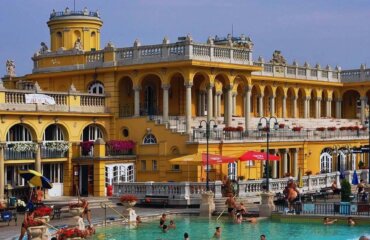5 Budapest legends and secrets
Incredible stories about our capital
Have you ever thought that so many secrets and legends revolve around the winding streets, centuries-old buildings and natural treasures of Budapest?
Now you can wander with us into the world of 5 urban legends.
1. The marble Bride
There is a house on Thököly street with a doorless balcony with a statue of a woman. According to legend, during the First World War, a young couple lived in the apartment. While the man was fighting on the front line during the war, his wife waited faithfully until one day the news of the man’s death was brought, which she did not believe. She felt like her husband was alive and that he will return to her one day. From then on, she spent every day standing on the balcony, waiting for her beloved husband to return home. At that time there was a Spanish rhinitis, so unfortunately it caused the woman’s death. She was right, on the next day her husband returned from the front line. The husband was so devastated he erected a statue to his faithful wife, and he bricked up the balcony door so no one could step out of it anymore.
The truth:
The house was originally designed by architect Lajos Ybl, before the First World War. His son studied at the Sorbonne University in Paris, so that’s where he got the idea of a figure watching on the balcony from. The bride has a pretty but freezing face, but in fact the bride does not have legs.
2. Natives in the zoo
Legend has it that in the late 1800s, in addition to the animals, those who visited the Capital Zoo could see more. One of the fenced areas was inhabited by a Negro tribe, who came to Budapest from Africa in honor of the millennium holiday. This tribe was considered very interesting as they were African people, who were much rarer and different spectacle in those days. It was worth the money spent on the entrance fee, so people could see a completely different culture, which was not what they were used to. The article from the Sunday News 1896, also reveals how these people got here. The director of the zoo served in the French Navy and went to Africa. Every year he selects a new team of black people, which he presented in various zoos around the world, including Budapest.
The truth:
Examining several sources, these legends seem to be true. From 1884, the former zoo merchant Carl Hagenbeck actually invited distant ethnic groups to the zoo.
3. Norma, the tree giant
On the slope of today’s Normafa stood an old beech tree which according to legend, sprouted at the birth of King Matthias. The tree has been struck by lightning several time over the years, but it has also suffered damage not only from nature but also from human hands. In 1927 the tree giant fell out and a new beech tree was planted in 1962, and today a memorial plaque stands on the site of the original tree. The fallen tree truck was placed in the basin of the Margaret Island artesian spring.
4. Who was Gül Baba?
Gül Baba’s tomb is reminiscent of nearly 150 years of Turkish rule in Hungary. Gül Baba was the head of a monastery. According to legend, Gül Baba died under strange circumstances. In 1541, the Turkish army occupied Buda, and a Thanksgiving service was held in the Church of the Assumption, when he died. However, the Turkish believe, that he was wounded in the battle during the occupation of Buda Castle. After his death, a tomb chapel was built in a rose garden next to the monastery. Since the consecration of the place, it has become an Islamic place of pilgrimage.
5. The medieval downtown
The medieval town plan is one of the most important historical monuments in the city center. Between 1450 and 1470 King Matthias surrounded Pest with a wall for military and defend reasons. The length of the city wall was more than 1.7 kilometers. Until the end of the 1780s, the city wall remained intact, but the rapid economic development was prevented by the city wall. But the line of the city wall remained important, as they built many institutions of urban trade, such as the National Museum, the old House of Representatives, The Great Market Hall and the Corvinus University of Budapest.






